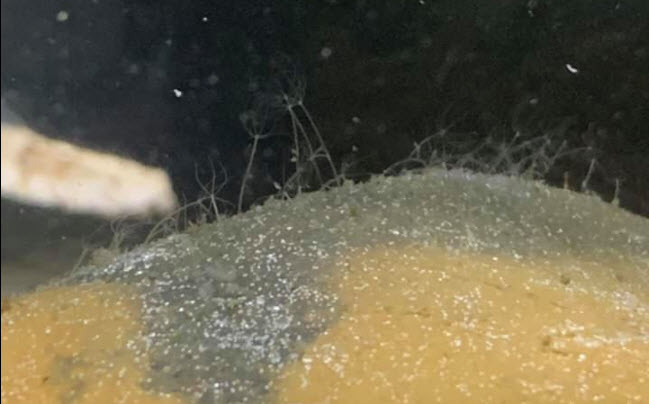
Hydra are small creatures often found attached to the aquarium glass, rocks and decorations in the aquarium. Hydra are small-sized polyps from the same phylum (Cnidaria) as sea anemones, corals and jellyfish and resemble tiny anemones. While anemones are marine, hydra lives only in freshwater. Hydra have a tubular body attached to a surface at one end. On the other end are six to twelve arms, waving in the current. These arms have stinging cells on them.
NEVER squash a hydra. Each tiny bit of hydra that results when one squishes a hydra will grow into a new hydra.
Hydra typically show up when some plants (and sometimes fish) are put in a relatively new aquarium. And they generally disappear after a few weeks or a few months. If one is feeding fry with brine shrimp or with water fleas (daphnia) hydra can persist forever and be a real problem. Hydra love to eat brine shrimp and water fleas and they can eat the fry of fish and young shrimp.
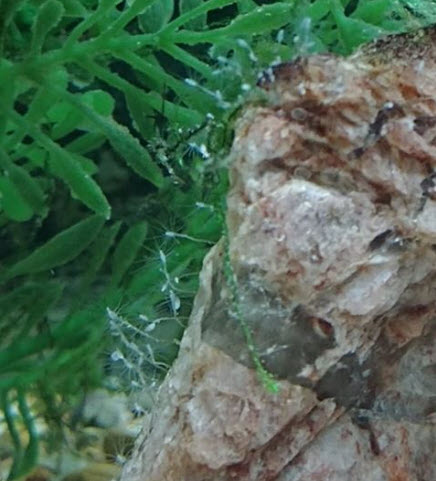
There are hundreds of species of hydra, some quite atypical, with visible white arms but invisible, clear bodies. Most are white but some are green and brown. Some have long stalks and long arms, others have short stubby stalks and short stubby arms. Some have arms on the arms, which can produces a really bizarre creature. Some are half an inch in size while others are less than a twentieth of an ich in size. They all wave in the water with the current.
Some species of hydra create chains of polyps up to an inch long. These species bud at the top “head” of the organism, and the hydra then form a series of foot on head hydra that can be two to four hydra long (chains longer than four are typically bryozoans).
It is very common to have hundreds or even thousands of small little filaments of “something” or “wisps” which are attached to the aquarium glass and moving back and forth in unison with the water flow. If one puts these “somethings” under a microscope one will typically find a hydra with a gray or white stalk and transparent arms. Occasionally other creatures like epistylis or stentors will be found.
When one has individual evenly spaced wisps on the glass of the aquarium, one wisp every centimeter or so, suspect hydra. Hydra typically “like their own space”. Algae grow in variable diameter clumps which are not evenly spaced.
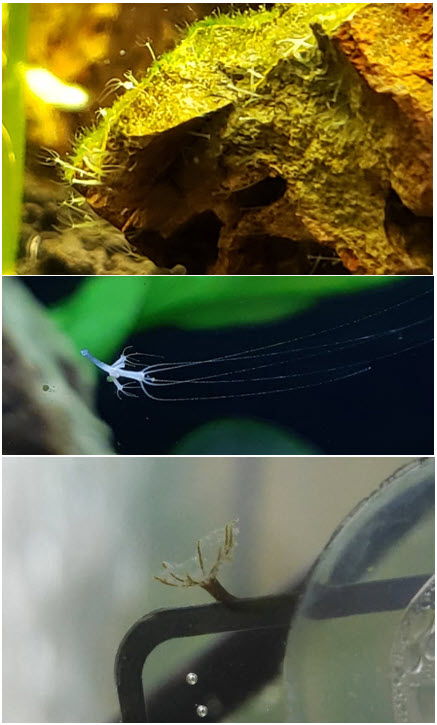
The hydra species normally found in the aquarium feed largely on small crustaceans like copepods (cyclops), ostracods (seed shrimp), and cladocera (daphnia). These small crustaceans feed in turn on a complex mixture of organisms called infusoria. Infusoria are the complex mixture of minute aquatic creatures such as ciliates, euglenoids, protozoa, unicellular algae and very small invertebrates. Infusoria are the cause of cloudy or “dull” water.
Hydra generally proliferate in a aquarium which is overfed, has a new filter and/or has too large of a substrate. A large substrate will allow food to get down in the substrate and rot. The rot produces infusoria. The small crustaceans feed on the infusoria and the hydra feed on the crustaceans. The best way to reduce the hydra population is to prevent the infusoria that crustaceans feed on from forming.
One should only feed fish 1% of their body weight if adult or 2% of their body weight if juvenile per day. This is not a lot of food. So the first thing to do with hydra is to look long and hard at the feeding. Note that shrimp are very low metabolism creatures that should be fed VERY sparingly if at all. In most well lit aquariums shrimp do just fine eating only algae growing in the tank. And of course the substrate in an aquarium should be smaller than 3/16 of an inch (5 mm) in diameter.
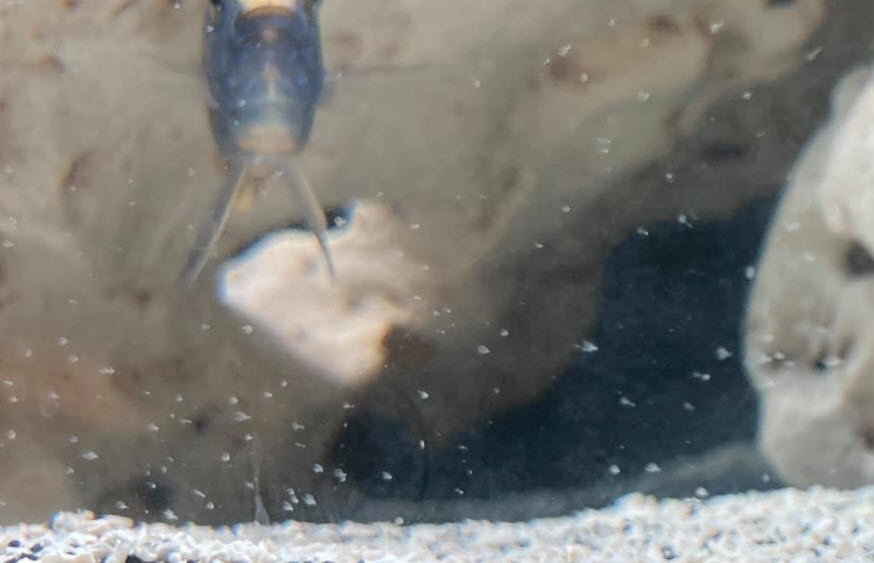
And note that a planted tank where the plants are not thriving is the same as adding a lot of food to a tank. The rotting leaves of the plants will feed a large population of infusoria and, in turn, crustaceans. This in turn can produce a hydra outbreak.
The next thing to look at in an aquarium with a lot of hydra is the filtration. It is common to get hydra in a new tank and then have the hydra simply disappear. What happened is that the filter became mature and filtered out the infusoria. When the infusoria stopped, the crustaceans starved and then the hydra starved. A large filter (canister or sump) with a lot of good media (foam, pot scrubbers or K1 type media) or an undergravel filter will typically filter out any infusoria and prevent hydra after a few weeks. A hang on back cartridge filter will not prevent hydra.
This is a photo of very small hydra on the glass of the aquarium. Many will call this “algae”. It is not. The spots are too regular and there are no “colonies”.
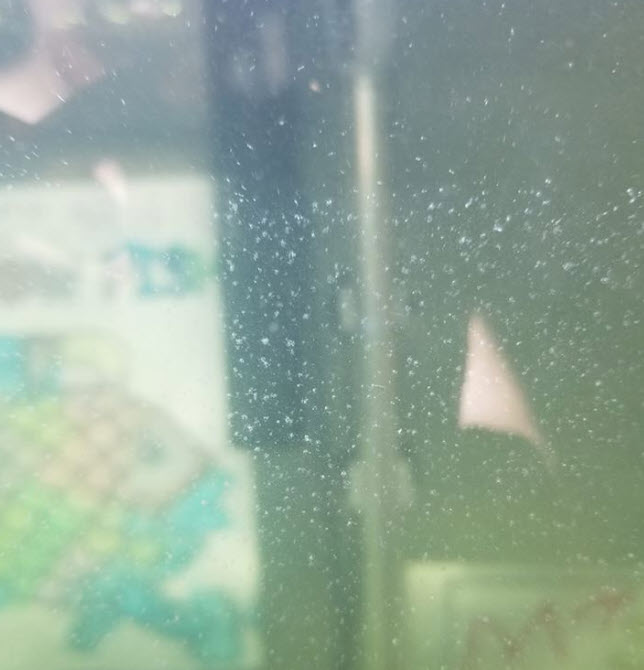
The easy way to identify hydra is to simply put a finger close to the hydra, almost touching it. A hydra will recoil. Algae will not recoil.
It is also a good idea to add an in line UV sterilizer to the filter flow lines. This kills the protozoan infusoria which feed the crustaceans the hydra feeds on and starves out the hydra. Here is a link to UV sterilizers:
14.1. UV Sterilizers
Also anything which gives crystal clear water, such as over-filtration, packed Polyfil, and/or UV sterilization will drop the hydra population down quite well. By eliminating the infusoria which are giving one “dull” water you eliminate the crustaceans that hydra feed on. For more on how to get crystal clear water go to the following link:
6.4. Crystal Clear Water
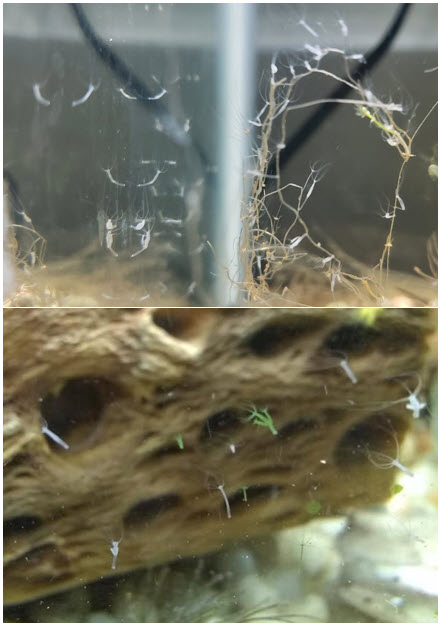
Hydra are generally harmless unless you have fish fry or shrimp. Hydra can eat baby shrimp and the fry of small fish.
Small fish such as guppies do not typically eat hydra. Possibly the hydra stinging cells are too much for them to handle. But larger fish such as gouramis, mollies and platies do appear to eat hydra. Still larger fish like Oscars and Jack Dempsey’s ignore hydra.
Medications for hydra are fenbendazole (dog de-wormers such as Panacur C and Safe Guard) and copper.
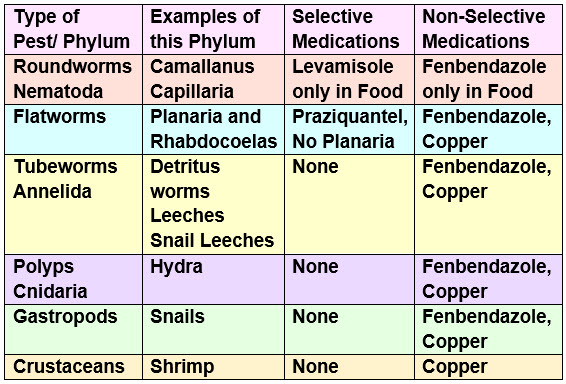
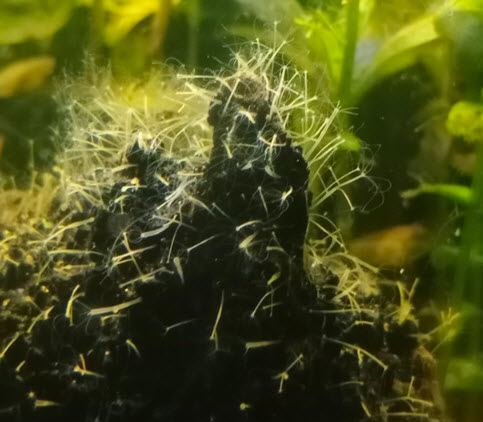
To eliminate hydra dose fenbendazole powder three times spaced three days apart per this chart:
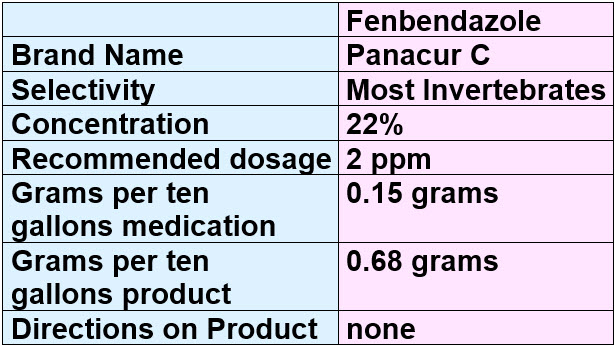
Mix the powder into a bottle half filled with water and then vigorously shake the bottle to break up all the lumps. Do NOT do water changes during treatment. Use a copper medication at the same strength as recommended for ich. Note that copper should not be used in soft water (GH<6).
Fenbendazole will kill hydra but typically will also kill some snails (reportedly it will kill apple and nerite snails but not ramshorn and bladder snails). Fenbendazole CAN kill shrimp IF overdosed. Copper treatment (Seachem Cupramine) at the same strength as for ich will eliminate hydra (but will also typically kill shrimp and snails). Note that the cautions about deaths of snails, shrimp and invertebrates is very dose dependent. Copper and Fenbendazole are often used with no snail deaths because the dosage isn’t high enough. But copper WILL kill shrimp at any reasonable dosage.
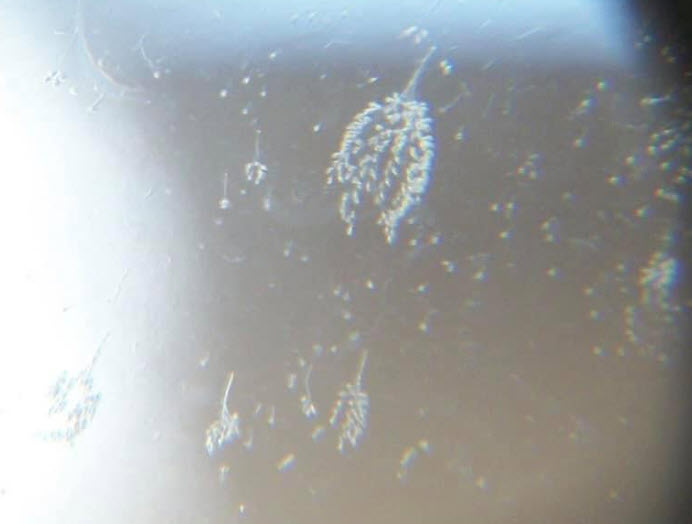
Also note that there are many websites which recommend a host of products to treat hydra in shrimp tanks. These recommendations have blue underlined links to the products, typically an Amazon website. If you click on these links and buy the product, the website receives a commission. If you found the website through a search engine like Google, the search engine receives a commission. Isn’t the profit motive wonderful? How accurate do you think the recommendations of such websites are? For that matter, how accurate do you think a search engine search is?
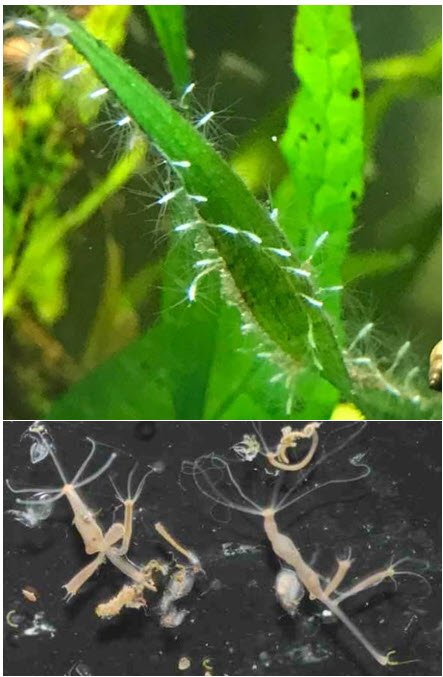
There are two animals often mistaken for hydra. These are Bryozoans and Stentors and they are covered in this article:
10.13.5. Bryozoans and Stentors
More Information
For more information on all the different pests found in an aquarium click on this link:
10.13. Pests in the Aquarium
Return to Diseases Menu
.
Aquarium Science Website
The chapters shown below or on the right side in maroon lead to close to 400 articles on all aspects of keeping a freshwater aquarium. These articles have NO links to profit making sites and are thus unbiased in their recommendations, unlike all the for-profit sites you will find with Google. Bookmark and browse!
.

Sasha says
I have a dirted 3L jar “ecosystem” with plants that I once set up for 5 dwarf shrimp to try my hand at the Walstad method. Then green hydra started apearing here and there. I was worried and wanted a more “natural” solution so I could get rid of hydra but keep all the remaining biodivercity in there (cyclops, ostracods, detritus worms, beneficial bacteria; also an apple snail that already lived in there, neocaridina shrimp).
I’ve read on aquariumbreader.com that Asolene Spixi snails can sometimes eat hydra. I bought one and it realy did. I even tryed placing it manually on affected leaves and rocks a couple times – once in close proximity, the snail seemed to target it and individual hydra seemed to disappear after the encounter. I was very proud of my new snail. After maybe a week I didn’t see any hydra in the jar anymore. 100% recommend.
I would sum up my anecdote like this: one Asolene Spixi may be enough to get rid of green hydra (photosynthetic ability of it may or may not be a factor) in a 3L filterless dirted planted set up. Pomacea diffusa ignore hydra.
P.S. my eanglish may be broken, sorry